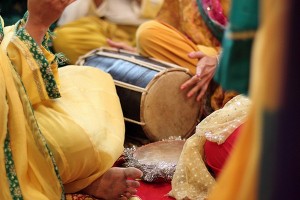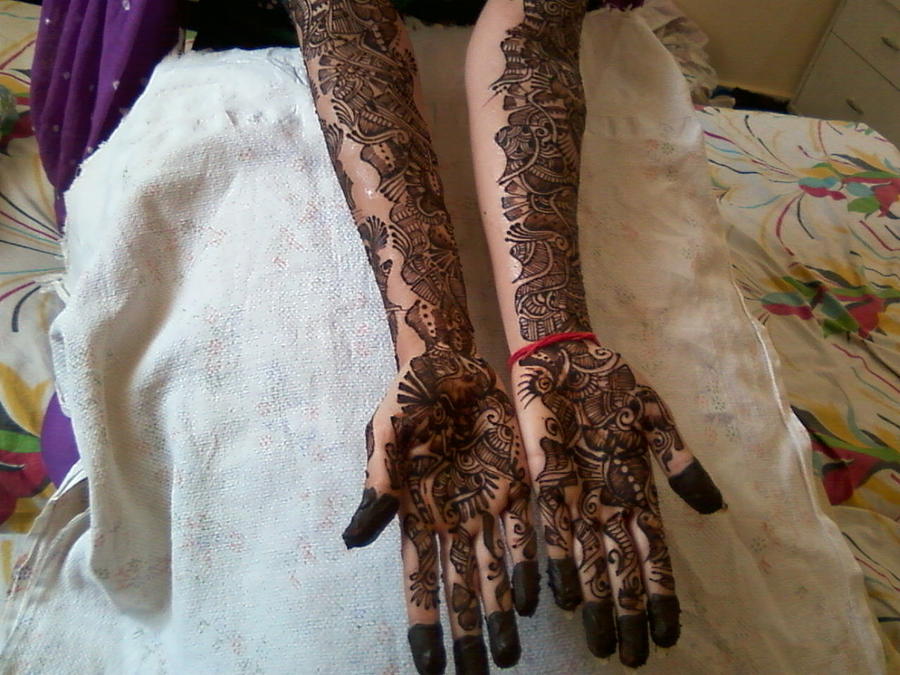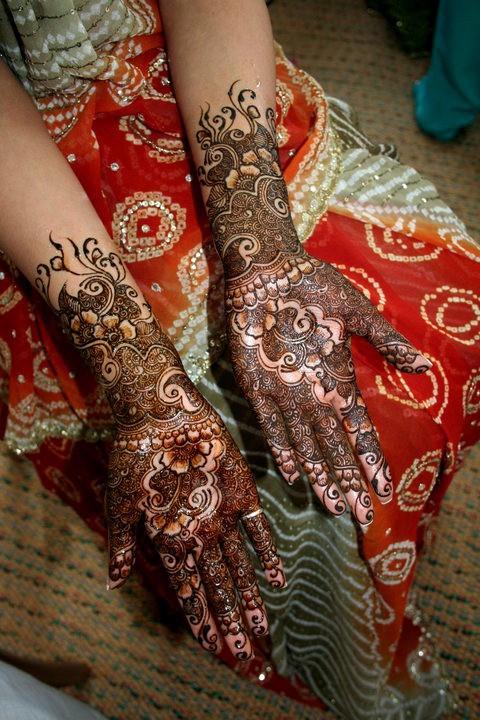Mehndi Arabic Designs Biography
Source(Google.com.pk)Mohandas Karamchand Gandhi, popularly known as Mahatma Gandhi was a major political and spiritual leader of India who led the country in the non-cooperation movement in 1922 and Salt march in 1930 and later in Quit India movement in 1942 during its struggle for independence. Known as Beloved Baapu in India, Mahatma Gandhi adopted the policy of mass disobedience and non-violent resistance as weapons against the British Rule in India and followed a principle of Ahimsa (total Non-Violence). He endured several hardships, was arrested and occasionally beaten in his journey and struggle to Justice and Freedom. However, his struggle does not restrict to India itself, as the leader played a key role in the Civil Rights movement in South Africa and secured them the right to justice and equality. His birthday 2 October is commemorated as Gandhi Jayanti, a national holiday and as the International Non-Violence day across the world.
Mohandas Karamchand Gandhi was born in Porbandar, a town in Gujarat in western India on 2 October 1869. His father Karamchand Gandhi was the Diwan of Porbandar state of British India. His mother Putlibai was Karamchand’s fourth wife. Having born in a Hindu family Gandhi strictly followed vegetarianism and fasting as means of self-purification. At the age of 13 he was married to one year older kasturba. In 1885, Kasturbai gave birth to their first child who survived only few days. Later the couple had four sons. All along his schooling days Gandhi was an average student and passed his matriculation exam from Samaldas College, Gujarat with some difficulty. On 4th September 1888, he traveled to England to study law at the university College London and to train as a barrister, as his family wanted him to be a barrister.
Civil Rights Movement in South Africa
In South Africa, he had a first hand experience of racial discrimination and prejudice directed at Indians and the injustice imposed on them. Gandhi himself experienced the humiliation and disgrace while in South Africa. Initially he was thrown off a train for refusing to travel in a third class coach while holding a first class ticket. Other similar events including being barred from many hotels in South Africa moved him and encouraged him to work for Indian people there. As a result he extended his original period of stay to protest a bill passed by the South African government to deny them the right to vote.
In 1906, the Transvaal government launched a new act forcing registration of Indian population. Enraged by the act, a mass protest meeting was held in Johannesburg on 11 September in which Gandhi called on Indian people to resist the new act through non-violent and peaceful means. His methodology of Satyagraha (devotion to truth) was adopted by thousands of his followers and during the seven-year long struggle; thousands of Indians were jailed (including Gandhi), beaten and punished for striking and refusing to register. Though the government successfully repressed the protest through its harsh methods, the impact of this protest forced the government to initiate for a compromise with Gandhi. Gandhi’s idea of non-violence and truth developed during this period.
Indian Independence struggle and Gandhi
(1916-1945)
Gandhi’s Satyagraha started from Champaran and kheda, where the condition of farmers was worsened by landlords (mostly British) by imposing taxes and leaving them in an abject poverty. The peasants were forced to grow cash crops instead of food crops necessary for their survival, and this led to a situation of famine there.
To end that devastating famine and poverty Gandhi organized detailed survey and study, based upon which he began leading the cleaning of the villages, building of schools and hospitals, encouraging villagers to condemn and combat many social evils including pardah and untouchability. Gandhi organized protests and strikes against the landlords that resulted in to the cancellation of the revenue hikes and collection of taxes until the famine ended.
Non-cooperation Movement
Gandhi employed non-cooperation, non-violence and peaceful resistance as the most effective weapons against the British rule. It was the Jallianwala Bagh massacre and the violence that followed, after which Gandhi felt an immediate need of a self-controlled government and total control over all Indian government institutions. The concept of Swaraj or complete individual, spiritual and political freedom evolved after this. Gandhi urged the people to boycott foreign made goods, cloths, to resign from government employment and to forsake British titles and honors. He encouraged people to wear khadi clothes instead of foreign made clothes. Gandhi himself wore a traditional Indian dhoti and shawl, made with yarn he himself spun on a Charkha.
The campaign was a big success nationwide and people from all sectors, including women of India participated in it. The movement ended in Feb 1922, when a violent clash in broke in Chauri chaura, Uttar Pradesh. Gandhi was arrested in March, tried for sedition and was sentenced to 6 years imprisonment. During his years in prison the Indian National Congress began to split into two parts, one led by Chitta Ranjan Das and Motilal Nehru and the other led by Chakravarty Rajgopalachari. Cooperation among Hindu and Muslims also weaken during this period. All efforts made by Gandhi to bridge the differences had little impact on them.
Salt March & Demand for Swaraj
The British government appointed a new constitutional reform under Sir John Simon which did not include any Indian and the result was a boycott of the commission by all Indian political leaders. In December 1928 Gandhi demanded the British government to grant India a dominion status and warned them to face a new non- cooperation campaign with a complete freedom as its goal, if their demands were not met. On 31st December 1929 Indian flag was unfurled in Lahore and next year, 26 January was celebrated as the Independence Day by the National Congress Party which was commemorated by almost every Indian organization. In 1930, Gandhi launched a new Satyagraha protesting the tax on salt. He marched from Ahmadabad to Dandi, Gujarat to make salt himself. Thousands of Indian people joined him in this 400km march which was marked as his most successful campaign against the British hold.
In March 1931 the Irwin-Gandhi pact was signed according to which the British government agreed to free political prisoners if Gandhi denounced the civil disobedience movement. In 1932, the government granted untouchables separate electorates under the new constitution. Gandhi started a new campaign to improve the lives of untouchables, whom he called Harijan, the children of God. Equality and justice for Untouchables became his prime goal and it was a result of Gandhi’s constant effort that in September 1932 the government agreed to adopt a more unbiased and fair arrangement via negotiation.
Freedom and Partition of India
During world war II in 1939, Gandhi opposed the inclusion of India in the war stating that India can not be a part of the war being fought for the democratic freedom, while freedom was denied to India itself. Gandhi and other Congressmen intensified their movement for a complete freedom demanding the British to ‘Quit India’. It was the most vigorous movement in the history of Indian Independence struggle in which thousands of freedom fighters were killed, imprisoned and injured and violent clashes broke in every part of India. The demand this time was a complete freedom and immediate exit of the British from India. Though Gandhi appealed to maintain discipline, he made it clear that even violent act wouldn’t stop their movement this time, as it was a time to Do or Die.
Gandhi and the committee of congress were arrested on 9 August 1942, and Gandhi was held in Aga Khan Palace for 2 years. During that period his wife Kasturba Gandhi died after 18 months of prison on 22 February 1944. At the end of the world war, Gandhi called off his struggle. Time had come to see an Independent India. Gandhi had always dreamed of India as a place where Hindu and Muslims lived in harmony and thus he was opposed to any plan that partitioned India into two different countries. A majority of Muslims living in India were in favor of the partition, including Muhammad Ali Jinnah. The partition plan was approved by the Congress leadership as they knew it was the only way to avoid a looming Hindu Muslim civil war. Against the wish of Gandhi, British India broke into two parts, an Independent India and Pakistan.
Assassination of Mahatma GandhiThere are so many mehndi designs are available in the market such as Pakistani mehndi designs, Indian mehndi designs, Arabic mehndi designs etc. If we talk about most popular mehndi designs then we have to mention Arabic mehndi designs. These days, Arabic mehndi designs are very popular among girls and brides. Here we will represent few but beautiful Arabic bridal mehndi designs for hands. In other words, these mehndi designs are specially created only for brides.These Arabic mehndi designs includes wide range of designs like floral designs, peacock designs, motifs etc. Brides will find so many Arabic mehndi designs for their front and back side of their hands. As these are specially designed for brides so all the mehndi designs are beautiful and stunning. These Arabic bridal mehndi designs for hands are not simple. So bride’s needs special professional help for applying these mehndi designs. Finally, if you are the future bride and you want to apply beautiful mehndi designs on your big day then check out these Arabic bridal mehndi designs. You will surely like all the mehndi designs.
In the Middle East, wedding seem incomplete without beautiful pattern of mehndi. Not only brides have the beautiful design of mehndi but her friends and family members have it too. In Pakistan and India, brides have the beautiful mehndi design on their hands and feet as it has been the tradition since the ancient times.
Mehndi is derived from the leaves of Henna Plant and converted into paste which is applied on the hands and feet. The mehndi designs of Pakistan and India are popular in all over the world. These styles looks well and enhance the beauty of the bride. The Arabic mehndi designs have also become very famous from the past few years. These mehdni styles are not only used to decorate hands, feet, arms of the bride but also used to design the back and belly of the bride. The Arabic styled mehndi have wide variety of designs that makes it very easy for the bride to choose the best one for her. Floral design is one of the most popular Arabic mehndi patterns nowadays. On the mehndi function, If you like to have some elegant floral design on the body such as hands, back or the belly, then choosing from the vast variety of Arabic design will allow you to have the most stunning pattern for the occasion.
In Pakistan, the significance of mehndi is well known because one complete function of the pre-wedding ceremony dedicated to the mehndi ceremony. Many beauty parlors offer various packages for the bridal makeup and beautiful mehndi designs. Some brides like to have mehndi pattern on the belly and back as well in order to surprise the groom.
In the life of every woman, wedding is the most important occasion and she starts preparing years before the ceremony. The entire function lasts for only three days and the moments became memorable in her entire life.
If you are looking for some of the stunning looking Indian mehndi designs 2013 for Eid festival then we are sure that this article will going to be much informative for you. As we all know that Eid is always said as incomplete for the women without the mehndi applications. There are many new Mehndi designs that have appear in favor of the women for the hands and feet. Some of the best known mehndi types are Arabic Mehndi designs, Pakistani Mehndi designs and Indian mehndi designs as well. In this post we are sharing some of the pictures regarding Indian mehndi designs 2013. In these designs the women will going to find out the floral designs, peacock designs as well. Some of the Eid mehndi designs are even revolving around the traditional looking Rajasthan style of designing as well that is quite getting famous amongst the Indian women. These designs have been set for both the hands and feet that are much eye catching impressive looking for the women. The women can even make all of these mehndi designs as eye catching all through the use of employing glitters as well.
So make your favorite choice of the stunning looking Indian mehndi designs 2013 for Eid festival right now.
Gandhi was assassinated on 30 January 1948 on the grounds of Birla house, New Delhi. The assassin, Nathuram Godse, who had links to the extremist Hindu group Hindu Mahasabha shot him dead because he was against Gandhi’s sympathy for Pakistan. Godse and his co-conspirator Narayan Apte were tried and executed on 15 November 1949. Gandhi’s memorial on rajghat, New Delhi bears his last words H
Mehndi Arabic Designs HD Mehndi Designs Beautiful Eid Collection For Girls Best Mehndi Designs

Mehndi Arabic Designs HD Mehndi Designs Beautiful Eid Collection For Girls Best Mehndi Designs

Mehndi Arabic Designs HD Mehndi Designs Beautiful Eid Collection For Girls Best Mehndi Designs

Mehndi Arabic Designs HD Mehndi Designs Beautiful Eid Collection For Girls Best Mehndi Designs

Mehndi Arabic Designs HD Mehndi Designs Beautiful Eid Collection For Girls Best Mehndi Designs

Mehndi Arabic Designs HD Mehndi Designs Beautiful Eid Collection For Girls Best Mehndi Designs

Mehndi Arabic Designs HD Mehndi Designs Beautiful Eid Collection For Girls Best Mehndi Designs

Mehndi Arabic Designs HD Mehndi Designs Beautiful Eid Collection For Girls Best Mehndi Designs

Mehndi Arabic Designs HD Mehndi Designs Beautiful Eid Collection For Girls Best Mehndi Designs

Mehndi Arabic Designs HD Mehndi Designs Beautiful Eid Collection For Girls Best Mehndi Designs
Mehndi Arabic Designs HD Mehndi Designs Beautiful Eid Collection For Girls Best Mehndi Designs

Mehndi Arabic Designs HD Mehndi Designs Beautiful Eid Collection For Girls Best Mehndi Designs

Mehndi Arabic Designs HD Mehndi Designs Beautiful Eid Collection For Girls Best Mehndi Designs

Mehndi Arabic Designs HD Mehndi Designs Beautiful Eid Collection For Girls Best Mehndi Designs

Mehndi Arabic Designs HD Mehndi Designs Beautiful Eid Collection For Girls Best Mehndi Designs

No comments:
Post a Comment